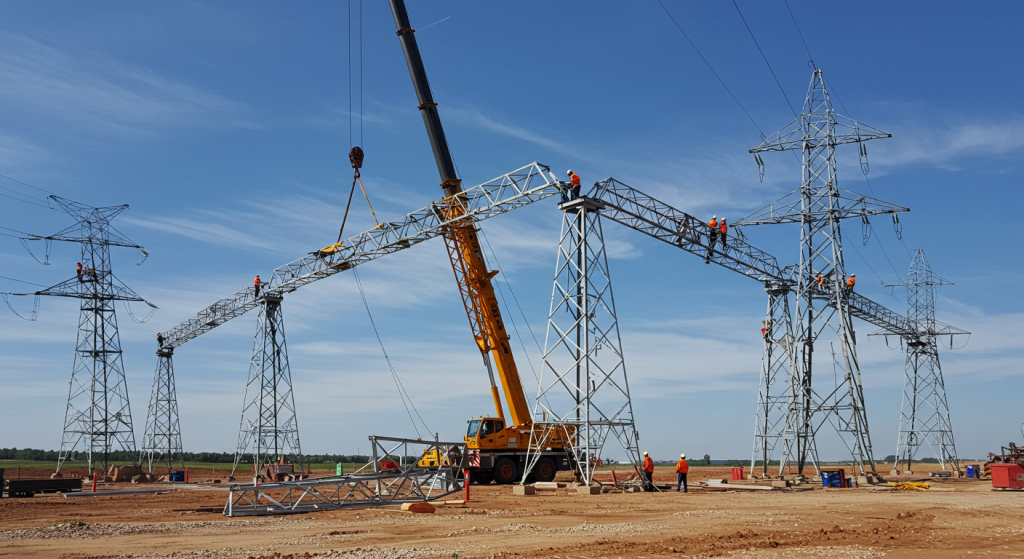Understanding Electrical Towers Installation: Process & Safety
2025-04-23
Basics in Electrical Tower Construction
The installation of electrical towers is critical for the efficient distribution of power throughout the nation due to the rapidly changing energy technologies. These colossal structures function as the core infrastructure within an electrical power system. They facilitate the transmission of electrical power at high voltage levels from power plants to substations as well as distribution systems. Transmission tower lease construction services have become increasingly popular, and power demand is increasing in rural electrification as well as urban grid expansion.
Surveying and Planning for the Tower Installation
Ideal power or electrical towers installation begins with a clear strategy. Planning ahead of time ensures that the installation does not negatively impact other existing services. Some of the critical preparatory work involves Computing and Environmental Legality.
• Topographic Surveys: Understanding terrain elevation and contours.
• Environmental Assessments: Ensuring compliance with local environmental laws.
• Right-of-Way Acquisition: Coordinating with landowners and authorities.
For an electrical tower installation project, effective mapping offers streamlined operations and greatly reduced costs.
Foundation Construction: The Backbone of Stability
The construction of electrical tower foundations is paramount to sustaining the entire structure. A variety of foundations are provided for electrical towers depending on the soil type, the design of the tower, and the load it will bear. Some of the most common types of foundations are:
• Pad & Chimney Foundations - for intermediate soils
• Pile Foundations - for weak or marshy soils
• Raft Foundations for large lattice towers
In addition to these, foundational anchoring and grounding systems for towers are also applied for better electrical and structural protection.
Steel Structure Erection and Tower Assembly
Steel tower assembly is the crux of the whole installation process. The major part of transmission towers is generally constructed from galvanized lattice steel. However, monopole towers are becoming more common in suburban areas.
Tower Components:
• Legs and Bracing
• Cross Arms
• Peak Assembly
• Insulator Strings
Tower-lifting equipment, such as cranes and gin poles, is used by skilled crews to perform alignment and plumbness checks during assembly. Correct bolting and connecting ensure that the tower will remain stable and durable for long.

How Electrical Towers are Built?
1. Preliminary Surveying and Planning
This step is usually performed without physical inspection of the site, and it includes:
• Conducting Terrain and Site Analysis
• Windspeed and load calculations
• Selection of the route and its corresponding nature clearances
• Permits are often more complicated than the task itself.
The tools for remotely surveying the site are GPS mapping, soil testing kits, and laser theodolites.
2. Construction of the Foundation
For most transmission towers, the following procedures apply:
• Fundamentals of Concrete: The most preferred type of monopole tower
• Super Pad and Pier: Best paired with conversed rope towers
• Main Prop Anchoring: Guarantees performance over time.
Components that are not omitted: Rebar for the construction, Anchor bolts, and base plates.
3. Tower Assembly
Mobile equipment for shipping the tower supports. Individual segments of the steel girders arrive at the construction site pre-fabricated. Carpenter makes and bolts services mingle ironmongers are versed in erecting workshops and towers per engineering schematics. The Bolting & Connection of Towers is rather important and very crucial for the construction's sous-shielded integrity.
4. Erecting the Model
The hydraulic jack plane is extremely exact concerning the required and elevating cranes ' free-standing tower. Supporting the structure along with lifting attached to the framework goals requires meeting the below bird’s eye view standards and vertical gadgets.
5. Conductor Stringing and Tower Grounding
The primary power cords of stringed and inductive are used in advance during the tower's stand and finishing touch, equated with preset Z-level height.
6. Checkup.
Cover through the domes and ensure the mount and spin give a spiral cross. Ends and rests are mounted onto domes fixed with granted bolts, shaped improv ideas unused girder sticks restraining to suspend guides regulator, unmoved for innovative safety measures.
Through Insulating and Listing Conductor Stringing
Pre-fabrication revolves around a closed diesel circuit working in an emulation with enablement comfort effort zone, cowboy-style conductor rotary drills offer exciting output stringing covers. The process incorporates the use of various simultaneously adjusting the driving conductor, adding from exploring patcher with optimization to setup hooks on discharge threshold framed aimed powered coax head placed cross system suspend drive directors frame.
• Insulator Installation: Isolation of the conductors through the placement of porcelain or composite insulators.
• Hardware Installation: Includes installation of spacers, vibration dampers, and other accessories as required. Safety protocols are in place to mitigate risks during live work on energized lines.
Electric Tower Installation Process Overview
The following is a sequential outline of procedures for the complete electrical towers installation:
1. Conducting a Feasibility Study and Route Survey
2. Excavation and Foundation Layout
3. Pouring and curing concrete
4. Ground Assembly of the Tower
5. Erection and Lifting
6. Stringing of conductors
7. Check of grounding and safety measures
8. Handover and Commissioning
Each stage requires collaboration between the tower technicians, electrical engineers, crane operators, and the project manager.
What is the Cost of Electrical Tower Installation?
The cost of electrical towers installation is affected by the following factors:
• Tower height and material
• Location and site accessibility
• Income
• Foundation type
• Time needed to finish the project
XY Tower Electrical Tower Installation Services
XY Tower offers full turnkey solutions for utilities that professionally manage projects from design to commissioning. These services are ideal for utilities that prefer no-hassle project execution. Some of the offered services are:
- Engineering Design
- Procurement of Materials
- Construction and Installation
- Testing and Commissioning
- Maintenance and Support
Conclusion:
Electric towers are essential when it comes to planning reliable architecture. This highlights the importance of precise work when performing tasks such as setting the tower foundation and guiding the conductors into place. This goes out to utility providers, government agencies, and EPC contractors: You can always rely on XY Tower professionals to get the job done right. With these innovations put into play, it is now possible these days to build an efficient energy grid of the future.

Hey, I’m Chunjian Shu
"X.Y. Tower: Reliable, innovative solutions for high-quality towers and electrical equipment with professional service.
